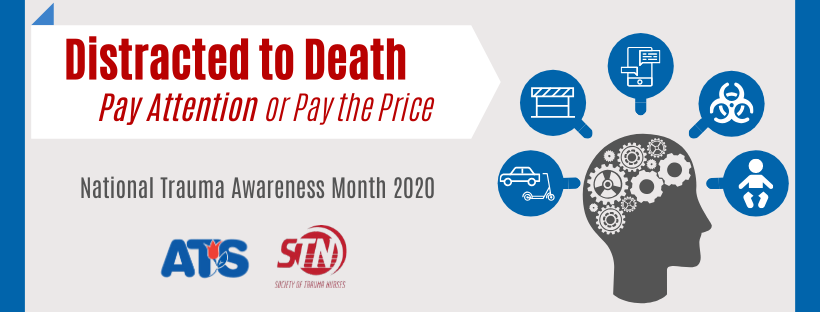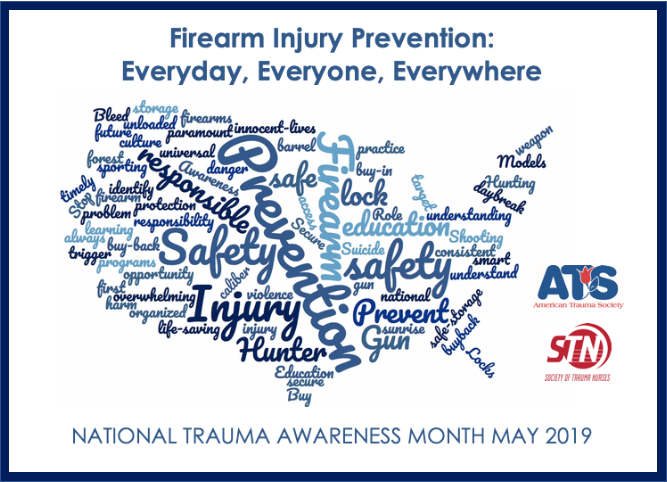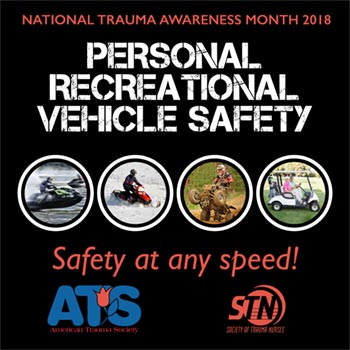
""Safe and Secure: Safety Is a Choice, Prevention is Key""
The ATS reminds our members that with the current COVID-19 pandemic, social distancing is strongly encouraged. NTAM promotions and educational events should be conducted through social media and virtually. In-person events should not be held until further notice.
National Trauma Awareness Month 2021
Once again, the American Trauma Society (ATS) and The Society of Trauma Nurses (STN) have come together in the development of the annual National Trauma Awareness Month (NTAM) campaign. With a global pandemic on our doorsteps the theme “Safe and Secure: Safety is a Choice, Prevention is Key “ is both timely and appropriate for our trauma centers to promote. Injury Prevention professionals from throughout nation have seen a rise in injuries related to the ways we have been living our lives during a pandemic. Raising awareness and supporting prevention efforts in this new way of living, working, and playing is more important now than ever. We need to be Safe and Secure in all that we do.
Did You Know?
In March 2020, the World Health Organization (WHO) declared the spread of the COVID-19 virus a global Pandemic. The Center for Disease Control (CDC) and Prevention emphasized the most effective way to quell the spread of the virus was to take and sustain preventative measures such as wearing a mask, quarantining, maintaining safe distancing and handwashing. Millions of homes were turned into workplaces, children went to school remotely if they did at all, summer vacations shifted away from the traditions of the past, and travel by car increased As of mid-February, 2021, there were over 27 million reported cases of COVID and 2.4 million deaths from COVID globally. Aggressive and sustained adherence to preventative measure may have avoided much of the spread of the virus. Prevention is the key in the slowing of the spread of the virus.
Prevention is also a key ingredient in reducing Injury. Injury is the leading cause of death for people between the ages of 1 to 44 years old representing 59 percent of all death in the United States. According to the Center for Disease Control and Prevention (SDC), each year, approximately 214,000 people die from unintentional and violence related injury. The number of those that are injured and survive range into the millions. The impact of Injury can have long reaching effects such as lifelong disability, mental health disorders and cause financial instability.
The Economic Impact of Injury
The most recent estimates for lifetime medical and work loss cost of injuries and violence in the United States is about $1059 billion dollars (National Safety Council, 2018). The cost associated with fatal injuries was $214 billion while nonfatal injuries accounted for $457 billion (CDC, 2013).
Common Causes of Injury and Death
According to The National Safety Council (NSC) and CDC in 2018 the top 3 leading causes of preventable death, in ranking order, were motor vehicle crashes, falls and suffocation. The top 3 leading causes of non-fatal preventable injuries treated in emergency departments in ranking order from one to three were falls, struck by or against and overexertion.
Most Common Place of Occurrence
Home may be “where the heart is” as the saying goes, but it is also the most common place where injuries occur, both inside and outside of the home perimeter. The second and third most common places of occurrence respectively are recreation areas and streets / highways (MMW, 2016)
Prevention and Intervention
Most injuries are preventable. Choosing to be aware of one’s environment as well as staying informed on the latest safety facts is a great place to start with establishing a culture of safety in and out of the home or workplace. Following the rules of the road, safe-play and wearing appropriate safety gear are all essential in reducing preventable injuries.
How can we prevent injuries in different aspects of life?
Visit the resources developed by a committee of volunteers from the American Trauma Society (ATS) and the Society of Trauma Nurses (STN). The key areas of concerns related to distractions for your injury prevention team include:
- Home and Remote Work- Life
- Outdoors and Recreation
- Work and Transportation
- Self-Care
References
- CDC WISQARS, https://www.cdc.gov/injury/wisqars/cost/index.html. Retrieved 12/21/20
- Johns Hopkins Corona Virus Resource Center, https://coronavirus.jhu.edu/us-map, Retrieved 02/18/2021
- MMWR, https://www.cdc.gov/mmwr/volumes/65/wr/mm6503a10.htm. Retrieved 12/21/20
- National safety Council, https://injuryfacts.nsc.org/all-injuries/costs/societal-costs/ Retrieved 12/21/20
- Download the 2020 National Trauma Awareness Month logo here.
We urge you to start planning activities and make this year’s celebration the best one yet!
If you have materials that you would like included in these resources, please contact ATS Member Services at 1-800-556-7890 or
- Trauma Awareness / Trauma Survivors Day (Wednesday, May 19th)
- Tool Kit for Trauma Awareness Ceremony
- Trauma Awareness Ceremony Checklist
- Trauma Awareness Generic Ceremony Brochure
- Trauma Nurse Excellence Award Letter
- Sample Flyer
- How to Invite and Host Legislators or Policymakers
- How to Participate in Trauma Survivors Day



 The Society of Trauma Nurses, in collaboration with the American Trauma Society, is once again pleased to present National Trauma Awareness Month. This year, in honor of National Trauma Awareness Month's 30th anniversary, the theme will expand to cover injury prevention efforts as a whole and the concept that injury is no accident.
The Society of Trauma Nurses, in collaboration with the American Trauma Society, is once again pleased to present National Trauma Awareness Month. This year, in honor of National Trauma Awareness Month's 30th anniversary, the theme will expand to cover injury prevention efforts as a whole and the concept that injury is no accident.